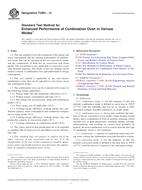We need your consent to use the individual data so that you can see information about your interests, among other things. Click "OK" to give your consent.
ASTM F1484-12
Standard Test Methods for Performance of Steam Cookers
STANDARD published on 1.10.2012
The information about the standard:
Designation standards: ASTM F1484-12
Note: WITHDRAWN
Publication date standards: 1.10.2012
SKU: NS-50463
The number of pages: 24
Approximate weight : 72 g (0.16 lbs)
Country: American technical standard
Category: Technical standards ASTM
The category - similar standards:
Cooking ranges, working tables, ovens and similar appliances
Annotation of standard text ASTM F1484-12 :
Keywords:
efficiency, energy, performance, production capacity, steam cooker, test method, throughput, ICS Number Code 97.040.20 (Cooking ranges, working tables, ovens and similar appliances)
Additional information
| Significance and Use | ||||
|
5.1 The maximum energy input rate test is used to confirm that the steam cooker is operating at the manufacturer's rated input. This test would also indicate any problems with the electric power supply, gas service pressure, or steam supply flow or pressure. 5.2 Preheat energy and duration can be useful to food service operators for managing power demands and knowing how quickly the steam cooker can be ready for operation. 5.3 Idle energy rate and pilot energy rate can be used to estimate energy consumption. 5.4 Green pea cooking energy efficiency is an indicator of steam cooker energy performance when cooking frozen products under various loading conditions. This allows the food service operator to consider energy costs when selecting a steam cooker. 5.5 Potato cooking energy efficiency is an indicator of steam cooker energy performance when cooking foods that require long cook times (for example, potatoes, beans, rice, lasagna or casserole rethermalization). The test demonstrates the difference in energy efficiency between pressure and pressureless steam cookers for this type of cooking event. The information may help a food service operator to evaluate what type of steamer to select (pressure versus pressureless versus dual pressure mode) from an energy performance perspective. 5.6 Green pea production capacity and potato production capacity can be used by food service operators to choose a steam cooker to match their particular food output requirements. 5.7 Water consumption characterization is useful for estimating water and sewerage costs associated with appliance operation. 5.8 Condensate temperature measurement is useful to verify that the temperature does not exceed regional building code limits. 5.9 Cooking uniformity provides information regarding the steamer’s ability to cook food at the same rate throughout the steamer’s compartment. |
||||
| 1. Scope | ||||
|
1.1 These test methods evaluate the energy consumption and cooking performance of steam cookers. The food service operator can use this evaluation to select a steam cooker and understand its energy consumption. 1.2 These test methods are applicable to the following steam cookers: high-pressure, low-pressure, pressureless and vacuum steam cookers (Specification F1217 Grades A, B, C and D); convection and non-convection steam cookers; steam cookers with self-contained gas-fired, electric, or steam coil steam generators, and those connected directly to an external potable steam source (Specification F1217 Styles i, ii, iii, and iv). The steam cookers will be tested for the following (where applicable): 1.2.1 Maximum energy input rate (see 1.2.2 Preheat energy consumption and duration (see 1.2.3 Idle energy rate (see 1.2.4 Pilot energy rate (see 1.2.5 Frozen green pea cooking energy efficiency (see 10.8). 1.2.6 Frozen green pea production capacity (see 1.2.7 Whole potato cooking energy efficiency (see 1.2.8 Whole potato production capacity (see 1.2.9 Water consumption (see 1.2.10 Condensate temperature (see 1.2.11 Cooking uniformity (see 1.3 The values stated in inch-pound units are to be regarded as standard. The SI units given in parentheses are for information only. 1.4 This standard may involve hazardous materials, operations, and equipment. It does not address all of the safety concerns, if any, associated with its use. It is the responsibility of the user of this standard to establish appropriate safety and health practices and determine the applicability of regulatory limitations prior to use. |
||||
| 2. Referenced Documents | ||||
|
Similar standards:
Historical
1.10.2011
Historical
1.4.2014
Historical
1.12.2011
Historical
1.9.2010
Historical
1.5.2010
Historical
1.1.2014
We recommend:
Updating of laws
Do you want to be sure about the validity of used regulations?
We offer you a solution so that you could use valid and updated legislative regulations.
Would you like to get more information? Look at this page.



 ASTM F2519-05(2011)e..
ASTM F2519-05(2011)e.. ASTM F2521-09(2014)..
ASTM F2521-09(2014).. ASTM F2800-11
ASTM F2800-11 ASTM F2834-10a
ASTM F2834-10a ASTM F2835-10
ASTM F2835-10 ASTM F2861-14
ASTM F2861-14
 Cookies
Cookies
